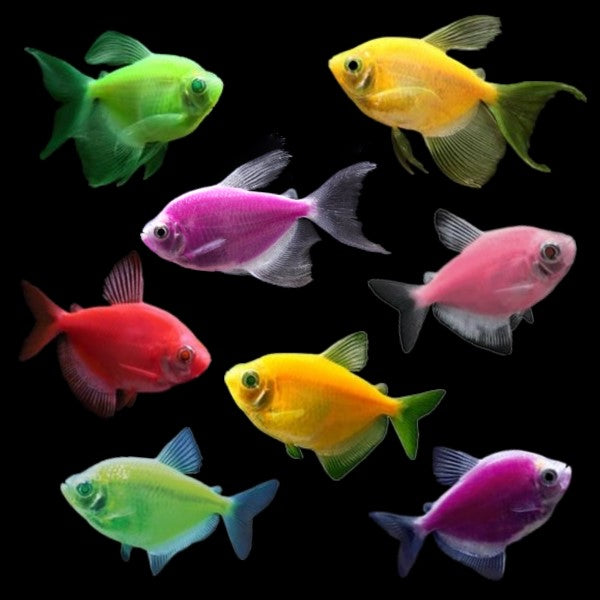Species Name: Glofish Tetra (Gymnocorymbus ternetzi)
Description:
GloFish Tetras are a genetically modified variation of the common Tetra fish (usually the Black Skirt Tetra or White Skirt Tetra) that exhibit vibrant fluorescent colors. These colors are a result of a naturally occurring fluorescence gene found in certain species of jellyfish, corals, and other marine organisms, which has been inserted into the tetra's DNA. GloFish Tetras are available in various colors such as Starfire Red, Sunburst Orange, Moonrise Pink, Electric Green, Cosmic Blue, and Galactic Purple, making them highly attractive and popular in the aquarium trade.
Habitat:
GloFish Tetras, like their non-genetically modified counterparts, are native to South America, primarily found in the Amazon River Basin and its tributaries. They prefer slow-moving waters with dense vegetation and subdued lighting.
Behavior:
GloFish Tetras are social and schooling fish, meaning they thrive in groups. They are generally peaceful and can coexist with other non-aggressive fish species. Their schooling behavior provides them with security and reduces stress, making them a great addition to community aquariums.
Diet:
These tetras are omnivorous, feeding on small insects, crustaceans, and plants in the wild. In captivity, they can be fed high-quality flake or pellet food. Additionally, they enjoy live or frozen foods like brine shrimp and blood worms, which help enhance their colors.
Care Requirements:
GloFish Tetras require a well-planted aquarium with plenty of hiding spots and subdued lighting to minimize stress. They thrive in slightly acidic to neutral water conditions with stable parameters. Regular water changes are essential to maintain their health and vibrant colors. It's important to provide them with a balanced diet and ensure they are kept in suitable tank mates to prevent stress-related illnesses.
Interesting Fact:
GloFish Tetras are not found in the wild; they are exclusively bred for the aquarium trade. Their fluorescent colors are a result of genetic modification, allowing them to fluoresce under certain lighting conditions, creating a captivating visual display in aquariums.
Please note that the genetic modification of animals for ornamental purposes raises ethical concerns, and it's important for aquarists to be aware of the origins and ethical implications of the fish they choose for their aquariums.
OpenAI. (2023, October 12). Glofish Tetra: Species Profile.


Comments
Post a Comment